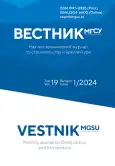Оценка уровня обслуживания улиц и общественных пространств: на примере исторического Алеппо
- Авторы: Данилина Н.В.1, Алибрахим Л.1
-
Учреждения:
- Национальный исследовательский Московский государственный строительный университет (НИУ МГСУ)
- Выпуск: Том 19, № 1 (2024)
- Страницы: 11-25
- Раздел: Архитектура и градостроительство. Реконструкция и реставрация
- URL: https://bakhtiniada.ru/1997-0935/article/view/254464
- ID: 254464
Цитировать
Полный текст
Аннотация
Об авторах
Н. В. Данилина
Национальный исследовательский Московский государственный строительный университет (НИУ МГСУ)
Email: nina_danilina@mail.ru
ORCID iD: 0000-0002-9465-6435
Л. Алибрахим
Национальный исследовательский Московский государственный строительный университет (НИУ МГСУ)
Email: linaalibrahim26@gmail.com
ORCID iD: 0000-0002-3332-9190
Список литературы
- Gargiulo C., Sgambati S. Active mobility in historical centers: towards an accessible and competitive city // Transportation Research Procedia. 2022. Vol. 60. Pp. 552–559. doi: 10.1016/j.trpro.2021.12.071
- Blanco I., Bonet J., Walliser A. Urban governance and regeneration policies in historic city centres: Madrid and Barcelona // Urban Research & Practice. 2011. Vol. 4. Issue 3. Pp. 326–343. doi: 10.1080/17535069.2011.616749
- Carrión M.F. The historical centre as an object of desire. 2005.
- Салмо А., Щербина Е.В., Алибрахим Л.Я. Architectural and urban identity of Homs city // Вестник МГСУ. 2021. Т. 16. № 10. С. 1285–1296. doi: 10.22227/1997-0935.2021.10.1285-1296. EDN IGNNEQ.
- Данилина Н.В., Теплова И.Д. «Устойчивая» улица — формирование общественных пространств на городских улицах // Экология урбанизированных территорий. 2018. № 4. С. 74–80. doi: 10.24411/1816-1863-2018-14074. EDN YYFSYP.
- Rogers P.P., Jalal K.F., Boyd J.A. An introduction to sustainable development. London : Routledge, 2007. Pp. 301–305. doi: 10.4324/9781849770477
- Nasser N. Planning for urban heritage places: reconciling conservation, tourism, and sustainable development // Journal of Planning Literature. 2003. Vol. 17. Issue 4. Pp. 467–479. doi: 10.1177/0885412203017004001
- Щербина Е.В., Данилина Н.В. Градостроительные аспекты проектирования устойчивой городской среды // Вестник Иркутского государственного технического университета. 2014. № 11 (94). С. 183–186. EDN TALHUH.
- Ibrahim S. Mapping spatial social aspects of urban recovery in contested cities: A case of the historic commercial center of the ancient city of Aleppo // Proceedings HERITAGE 2022 — International Conference on Vernacular Heritage: Culture, People and Sustainability. 2022. doi: 10.4995/HERITAGE2022.2022.15764
- Тафия М.А. Tourism development in Aleppo after the war // Инновации. Наука. Образование. 2021. № 32. С. 755–772. EDN FNOKZI.
- Swaid B. Destiny of urban heritage in transformation of Syrian Cities (Case Study Aleppo City) //The First International Conference for Urban Heritage in the Islamic Countries (UHIC). 2010.
- Kousa C., Pottgiesser U. Development plan strategies of old Aleppo City and sustainable development goals between theory and practice // LDE Heritage Conference on Heritage and the Sustainable Development Goals. 2021. Nо. 10. Pp. 437–447.
- Chibli M. The Local Agenda 21 for Old Aleppo: Towards a sustainable urban settlement. Sustainable Building. Rotterdam : In-house Publishing, 2002. Nо. 6. Pp. 2041–2047.
- Vincent L., Sergie L. An urban history of Aleppo // Aleppo: Rehabilitation of the Old City. 2005. Nо. 10. Pp. 552–562.
- Fangi G. Documentation of some cultural heritage emergencies in Syria In August 2010 by spherical photrammetry // ISPRS Annals of the Photogrammetry, Remote Sensing and Spatial Information Sciences. 2015. Vol. II-5/W3. Pp. 401–408. doi: 10.5194/isprsannals-II-5-W3-401-2015
- Kousa C., Pottgiesser U., Lubelli B. Post-Syrian war residential heritage transformations in the old city of Aleppo: Socio-cultural sustainability aspects // Sustainability. 2021. Vol. 13. Issue 21. P. 12213. doi: 10.3390/su132112213
- Kotsoni A., Dimelli D. Urban regeneration of the historic center of Aleppo in Syria // The 7th International Conference on Architecture and Built Environment. 2020. Nо. 15. Pp. 227–212.
- Salkini H., Swaid B., Greco L., Lucente R. Developing a multi-scale approach for rehabilitating the traditional residential buildings within the old city of Aleppo (Syria) // Le Vie dei Mercanti. 2016. Nо. 11. Pp. 443–432.
- Shaheen S. Urban transportation problems and issues in homs-syria: analytical study of the current condition and proposing future solutions // International Journal of Engineering and Management Sciences. 2021. Vol. 6. Issue 3. Pp. 30–42. doi: 10.21791/IJEMS.2021.3.3
- Bhuyan P.K., Nayak M.S. A review on level of service analysis of urban streets // Transport Reviews. 2013. Vol. 33. Issue 2. Pp. 219–238. doi: 10.1080/01441647.2013.779617
- Chen K.C., Larry S.T. Determination of Level of Service (LOS) on different roads in kuching area (a case study) // Journal of Civil Engineering, Science and Technology. 2009. Vol. 1. Issue 1. Pp. 1–6. doi: 10.33736/jcest.61.2009
- Eads B.S., Rouphail N.M., May A.D., Hall F. Freeway facility methodology in highway capacity manual 2000 // Transportation Research Record: Journal of the Transportation Research Board. 2000. Vol. 1710. Issue 1. Pp. 171–180. doi: 10.3141/1710-20
Дополнительные файлы





